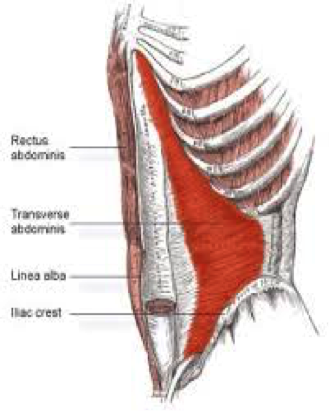Band camps are right around the corner. If you have worn a drum before, you know those first couple of days are going to be difficult on your body. It seems like there is nothing you can do to adequately simulate how wearing a drum feels on your back. During my drumline days I would prep for the fall with all of the most popular ab workouts I could find. I would YouTube the latest P90X and Insanity workouts, but this form of conditioning really did not seem to translate to the marching band field.
I did not know at that time that my workouts were lacking the involvement of two key muscles in developing a strong, stable core – the transverse abdominis (TrA) and the multifidus muscles. These muscles are needed for both static stability, such as maintaining proper carriage of a drum, and dynamic stability, the actual movements of the body during marching. In people with low back pain, these muscles have been shown to have delayed activation during activity1,2,3. Our goal is to properly train TrA and multifidus prior to the marching season so that your back is protected and so that you improve your marching abilities.
Transverse Abdominis
Transverse Abdominis (TA) is a lesser-known abdominal muscle, but it is typically the first abdominal muscle to contract during activity to stabilize your spine2. I used to think that when visual instructors would tell me to “tighten my core” that they were referring to the muscles that make up “6-pack abs”. Those “6-pack” muscles, called rectus abdominis, actually are not the primary stabilizing force that we need as marching percussionists.
The rectus abdominis muscles are only present in the middle of your core, and they are responsible for flexing your torso forward. This motion is completely negated during marching by the drum carrier, rendering it useless to helping us march better. On the other hand, TrA wraps around your entire abdomen and attaches onto your rib cage and pelvis on your backside. It takes up a much greater surface area to give you support.
Compare Figure 1 to Figure 2; TA conveniently has the same shape as the “belly plate” of a drum carrier! By sustaining a transverse abdominis contraction, you can stabilize the belly plate and drum when marching. When properly activated, this muscle will help you move smoother and take stress off your back.1. Multifidus
Multifi-what? Multifidus is a muscle that connects each vertebrae in your spine to the vertebrae above it (see Figure 3). The main job of multifidus is to keep each vertebrae aligned properly in relation to the vertebrae above it. This muscle is a major stabilizer during the dynamic movement of marching. With every step that you take, multifidus is activated to allow controlled mobility, and make sure each of your vertebrae stay vertically aligned to those segments above and below it.
However, in people with pain in the low back and sacral region (area between the pelvic bones), multifidus is delayed in activation3. It is crucial for marching percussionists to develop and maintain proper control with this muscle to decrease risk of injury.
When training these muscles you want to focus on control rather than achieving a powerful contraction. Their goal is to provide prolonged stability during activity. For training of the transverse abdominis, start with 10 repetitions of 10 second contractions. Once you feel the muscle building endurance, increase the time to mimic the demands of a marching band show.
With multifidus, you want to focus on maintaining core control throughout the bird dog exercise. Once you achieve quality movement and technique, progress to anywhere between 30-50 reps of this exercise per set. A high number of reps will greater prepare your body for the long days of band camp than doing only a few repetitions would.
Content References:
Hodges PW, Richardson CA. Delayed postural contraction of transversus abdominis in low back pain associated with movement of the lower limb. J Spinal Disord. 1998;11(1):46-56
Hodges PW, Richardson CA. Inefficient muscular stabilization of the lumbar spine associated with low back pain. A motor control evaluation of transversus abdominis. Spine (Phila Pa 1976). 1996;21:2640-2650
Hungerford B, Gilleard W, Hodges P. Evidence of altered lumbopelvic muscle recruitment in the presence of sacroiliac joint pain. Spine (Phila Pa 1976). 2003;28:1593-1600 lumbopelvic
muscle recruitment in the presence of sacroiliac joint pain. Spine (Phila Pa 1976). 2003;28:1593-1600

